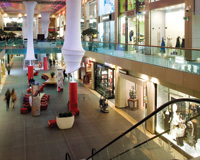Billed as Liverpool’s Bond Street, the 133,000 sq ft Metquarter shopping centre in Liverpool opened to great fanfare in 2006 as the go-to destination for the city’s WAGs.
In mid-2007, just as the retail investment market was beginning to cool, developers Milligan, Richardson Developments and JW Kaempfer sold the glitzy mall to Anglo Irish Private Banking and Alanis Capital, the investment vehicle of the Dublin-based McCormack family. It fetched around £87m, a yield of circa 5%.
That price was £10m below asking, but today it looks positively eye-watering as the very same shopping centre is brought to the market at 70% less than it sold for in 2007.
Last week, Estates Gazette revealed that Savills had been appointed to sell the Metquarter for around £25m – a circa 8% yield – in a consensual sale led by Irish Bank Resolution Corporation, the vehicle set up to wind down Anglo Irish (p41).
The Metquarter was one of a number of investments Alanis and Anglo Irish teamed up to buy during the property boom. Other shopping centres they jointly own include the 240,000 sq ft Kennet mall in Newbury, Berkshire, and the 80,000 sq ft Royal Exchange in the City of London.
They were thought to be included in the proposed sale of the property arm of Anglo Irish Private Wealth to Green Property in 2009 and then to Key Capital earlier this year. However, both deals collapsed. IBRC will now try to sell the properties itself individually over five years, with the Metquarter likely to be the first on the block.
When the Metquarter opened, it boasted 40 upmarket tenants – 39 of which were new to the city – such as Armani Exchange and LK Bennett.
Many of the retailers are understood to have opened on lease deals with rent increases linked either to inflation or turnover, rather than rent reviews. Both the landlord and tenants profited from the model when income levels were at the top of the market.
However, since then, the Metquarter has been buffeted by the cold headwinds in the wider retail market. Retailer collapses at the mall have included Miss Sixty, jewellery retailer Azendi and its anchor store, Flannels.
Since 2008, the Metquarter has also faced stiff competition from Grosvenor’s 2.4m sq ft retail-led development, Liverpool One.
“Liverpool One has had a huge impact,” says one source. “The Metquarter got to within 98% occupancy in 2006 and then Liverpool One hit it. It took the likes of Karen Millen, Coast and Hobbs. Metquarter’s anchor store, Flannels, went into administration but stayed in Liverpool One [after it was rescued]. The Metquarter has lost tenants because it can’t match Liverpool One [on deals]. The retailers can play landlords off against each other.”
But Peter Burke, head of retail and a director at Mason Owen, argues that the blame cannot be pinned on Liverpool One. “If anything, Liverpool One has made Liverpool a stronger retail destination,” he says. “But, in terms of value, the Metquarter was sold far too high. It’s a victim of general economic conditions. The Metquarter set itself firmly at operators that are not looking at high footfall but high spend.”
In recent years, the Metquarter has been fighting back. IBRC and Alanis have driven a clutch of new lettings at the scheme – many of which have been on traditional leases. It has secured Carluccio’s, cosmetic brand Illamasqua and Patisserie Valerie as well as Jack Wills for the former Flannels store. Much of the centre is now let: around 75% of the total space (or 66% by shops) is occupied.
So who will take on this investment? Sources say there are around 15 to 25 parties that could be interested in the potential acquisition of the mall. Interest is likely to come from property companies and opportunity funds which like turnaround projects.
“It will attract interest. The big question is whether an investor can come up with a role for the centre in Liverpool’s retailing future,” says one investment agent. “On a capital value per sq ft basis, it looks good value, and certainly appeals at the price relative to the original build cost.”
Milligan paid £17m for the site and paid Carillion £23m to build the centre. “But the bargain price tag is not enough of a reason to buy it,” the agent adds. “You need to know you can keep it full of retailers and generate a future stable income stream.”
Others warn that any new owner will have to redesign the centre to make a deal stack up. They argue that there is simply too much retail space in Liverpool now and that any new owner of the Metquarter will have to ensure the mall has a different offer to contrast with the mass market of Liverpool One and nearby Church Street. They claim that part of the Metquarter may even have to be converted to homes or leisure facilities.
“It is difficult to see the future for Metquarter in its current configuration arranged over two levels and 45 shop units, and hence significant reconfiguration or redevelopment and partial change of use are the most likely options for any owner,” says Cushman & Wakefield’s chief executive of retail, Justin Taylor. “Metquarter has inevitably suffered from having no anchor store or onsite car parking and has been completely overshadowed by Liverpool One.”
“The interest will whittle away fairly quickly when parties realise the detail to the [amount of work involved],” adds another agent. “The Metquarter has fantastic tenants, but there is a lot of work to do.”
Opened in 2006, sold for £87m in 2007 and now set to go on sale again for £25m – Annabel Dixon reports on Liverpool’s Metquarter shopping centre’s bumpy ride.











